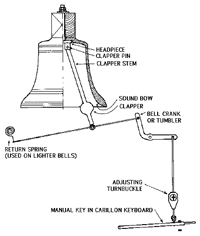- Home
- About carillons
About Carillons
A carillon is a musical instrument composed of at least 23 carillon bells, arranged in chromatic sequence, so tuned as to produce concordant harmony when many bells are sounded together. It is played from a keyboard that allows expression through variation of touch. The keys are struck with the half-closed hand. In addition, the larger bells are connected to foot pedals.
Although bells were first made during the Bronze Age, it was not until the 15th century that Flemish bell founders began to discover the process of accurately tuning bells - a process that occurs solely at the bell foundry. (Bells, unlike other musical instruments, do not go out of tune over time.) The 17th century was a golden age for the production of excellent carillons in the Low Countries of Europe. The art of tuning carillon bells almost died out by the 19th century, although bells of all kinds continued to be cast for many purposes.
It was only at the turn of the 20th century that carillon bell tuning began to be revived, eventually surpassing the quality and tuning of 17th-century bells and leading to the production of the many fine modern instruments now in existence. Thus there are numerous historical instruments that have the necessary number of bells and type of playing mechanism to be called carillons but are not always entirely harmonious to the ear. Although the Guild does not classify carillons according to the quality of their tuning, individual members do discuss not only tuning but also many other aspects of the quality of various carillons and promote various kinds of refinements.
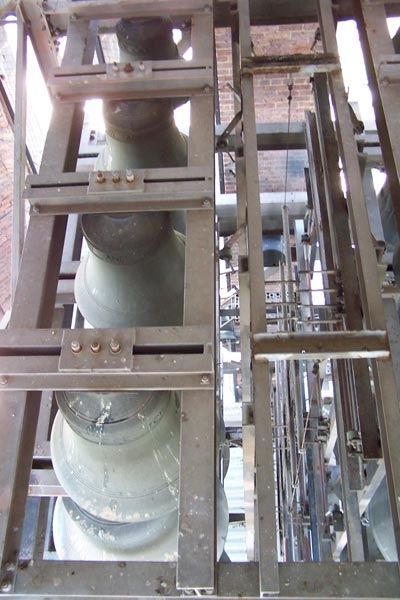 Carillons are usually installed in a tower, either in a partially enclosed bell chamber - which helps soften and blend the tones - or hanging from an exposed bell frame. The keyboard is either in a room directly below the bells or placed in a cabin located in the bell chamber among the bells. A few instruments have been mounted on trucks or trailers so that they can be moved from place to place for open-air performances.
Carillons are usually installed in a tower, either in a partially enclosed bell chamber - which helps soften and blend the tones - or hanging from an exposed bell frame. The keyboard is either in a room directly below the bells or placed in a cabin located in the bell chamber among the bells. A few instruments have been mounted on trucks or trailers so that they can be moved from place to place for open-air performances.
The world's greatest concentration of carillons is still in Belgium, the Netherlands, northern France and northwest Germany. The art of the carillon has spread worldwide, however, with instruments on every continent except Antarctica. There are more than 180 carillons in North America and more than 450 elsewhere in the world.
An instrument that is like a carillon in terms of the number of bells, but has only automatic action, is often loosely called a carillon, but is not recognized as a traditional carillon by the GCNA.
An instrument that is like a carillon but has less than 23 bells is called a chime. Several different types of playing mechanism are used in chimes, and there have been many instances in which good-quality chimes were eventually enlarged to become carillons. Although chimes are found in as many parts of the world as carillons are, there was a uniquely American development of them in the 19th century. About 700 are known in North America, and more than 500 in the rest of the world.
Carillon History
The carillon is an extraordinary musical instrument with a history as rich as it is long. For more than five centuries, the carillon has been a voice for the hopes, aspirations and joys of humankind.
Carillons evolved in the lowlands of Holland, Belgium and northern France. The rich mercantile towns of the lowlands exhibited their status by installing fine carillons in their church towers and arranging tunes to be played every quarter hour - or still more often - by an automatic mechanism. The town carillonneur played on market days and holidays. It was said that good bells and good schools were the sign of a well-run city.
The first well-tuned carillon was cast by the brothers Pieter and Francois Hemony, and installed in Zutphen, the Netherlands, in 1652. The Hemonys produced many fine instruments; their work set a standard to which modern carillons are still compared. By the time of the French Revolution, changing musical tastes and the wars sweeping across Europe put an end to the first "golden age" of the carillon. Although several Flemish and French founders continued to make large sets of bells, the tuning secrets of the Hemonys and their successors were lost. In addition, new "power" mechanisms were developed to make the carillon easier to play; unfortunately, these mechanisms sacrificed musicality for loudness and ease of playing.
Just before the turn of the 20th century, there was a resurgence of interest in this ancient instrument, due in large part to the efforts of Jef Denyn, carillonneur in Mechelen, Belgium. He improved the musical qualities of his carillon and began a series of weekly concerts that became famous beyond the borders of his own country. In particular, they inspired an American civil servant, William Gorham Rice, who wrote a series of books popularizing this Old World instrument. At the same time, developments in England led to the rediscovery of the art of bell tuning.
England never developed a tradition of playing music on sets of bells. Instead, the English invented a unique system of ringing mathematical variations on bells, called change ringing. Bells are swung in change ringing, so they were shortened to make them easier to swing. The negative effect this had on the tone of the bells was a serious consideration in change ringing. In the latter part of the 19th century, a Church of England clergyman and ardent bell ringer, Canon Simpson, began investigating why English ringing bells sounded so poor. He published his results in two articles in Pall Mall magazine, entitled "On Bell Sounds" and "Why Bells Sound out of Tune, and How to Cure Them." Later published in pamphlet form, these articles laid out the principles of five-point tuning, eventually adopted by English bell founders.
The first set of "Simpson" tuned bells was cast by the Taylor bell foundry of Loughborough, England, and installed in Ames, Iowa. Today, those 10 bells are the foundation of an important carillon at Iowa State University. Based on Simpson's work and a study after World War II by H. W. Van Heuven of bells removed during the war from towers in the Low Countries, modern founders now consistently surpass the standards set by the Hemony brothers over 300 years ago.
In addition to more accurate tuning, another advance of modern founders is the development of thicker profiles for the small treble bells, so their sound will balance.
Carillon Bells
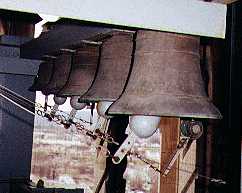 Carillon bells are cast from bell bronze, an alloy composed of approximately 78% copper and 22% tin, which is heated in a furnace to above 2,000 degrees Fahrenheit, until it melts and combines into a homogeneous liquid. The molten metal is then poured into a mold made up of a core, which is the shape of the inside section of the bell, and a cope, which is the shape of the outside of the bell. A bell's weight and profile, or shape, determine its note and the quality of its tone.
Carillon bells are cast from bell bronze, an alloy composed of approximately 78% copper and 22% tin, which is heated in a furnace to above 2,000 degrees Fahrenheit, until it melts and combines into a homogeneous liquid. The molten metal is then poured into a mold made up of a core, which is the shape of the inside section of the bell, and a cope, which is the shape of the outside of the bell. A bell's weight and profile, or shape, determine its note and the quality of its tone.
Once cast, a bell must be tuned. Most musical instruments produce a complex set of harmonically related overtones, or partials. A bell, on the other hand, produces a sound whose partial tones are not necessarily harmonically related. To produce a pleasing, harmonically related series of tones, the bell's profile is very carefully adjusted, or tuned, by the bell founder.
 Bell founders tune five principal tones of a bell. These are the hum tone, the lowest-pitched partial, produced by the vibration of the entire bell. An octave above that is the prime. This is the tone for which the bell is named, because it is also the pitch of the strike note, the most prominent tone heard when the bell is struck. Next is the tierce, sounding a minor third above the prime. The tierce is unique to bells and gives them their somewhat plaintive sound. Above that is the quint, a partial sounding a fifth above prime, and last is the nominal, sounding an octave above the prime and two octaves above the hum tone. There are many more partial tones, but these are usually the only ones tuned.
Bell founders tune five principal tones of a bell. These are the hum tone, the lowest-pitched partial, produced by the vibration of the entire bell. An octave above that is the prime. This is the tone for which the bell is named, because it is also the pitch of the strike note, the most prominent tone heard when the bell is struck. Next is the tierce, sounding a minor third above the prime. The tierce is unique to bells and gives them their somewhat plaintive sound. Above that is the quint, a partial sounding a fifth above prime, and last is the nominal, sounding an octave above the prime and two octaves above the hum tone. There are many more partial tones, but these are usually the only ones tuned.
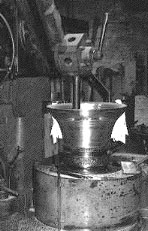 The casting process isn't sufficiently precise to produce a perfectly tuned bell profile, so carillon bells are cast slightly thick, then put on a lathe (see picture) where metal is cut from the inside surface to adjust the various partial tones. Each partial is tuned separately, by removing metal from a different area of the bell. The tuner aims to get the partials into a harmonically related series in which the strike note of the bell is in tune with the other bells in the ensemble. Once tuned at the foundry, a bell never needs further tuning in the tower. Bells over 300 years old sound as they did when they left their maker's hands. A bell's greatest enemies are fire, which can destroy the bell, and air pollution, which dissolves the bell metal, thus affecting the tuning.
The casting process isn't sufficiently precise to produce a perfectly tuned bell profile, so carillon bells are cast slightly thick, then put on a lathe (see picture) where metal is cut from the inside surface to adjust the various partial tones. Each partial is tuned separately, by removing metal from a different area of the bell. The tuner aims to get the partials into a harmonically related series in which the strike note of the bell is in tune with the other bells in the ensemble. Once tuned at the foundry, a bell never needs further tuning in the tower. Bells over 300 years old sound as they did when they left their maker's hands. A bell's greatest enemies are fire, which can destroy the bell, and air pollution, which dissolves the bell metal, thus affecting the tuning.
Playing Mechanism
Carillon bells are bolted to steel or wooden beams and do not move in performance. Instead, the clappers, which are connected by a direct mechanical linkage to the keys of the keyboard, move to strike the bell. The carillon's mechanical playing action, like that of the piano, gives the performer the ability to control dynamics and phrasing by variation of touch.
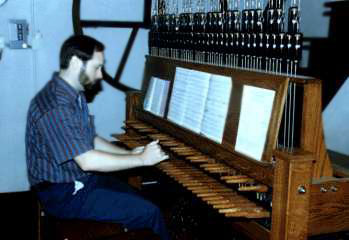 Although the traditional carillon keyboard (sometimes called a clavier) shares some similarities with other keyboard instruments, performance technique is unique to the carillon. The keyboard has a manual key (played by the hand) for each note in the carillon. These keys are sometimes called batons because they are wooden levers about 2 feet in length, and rounded at the playing end, resembling batons. In addition, there are one to two octaves of pedal keys, played with the feet, that pull down the corresponding manual keys. This permits a performer to play the heavy bass bells with the feet, while still using hands in the middle and upper octaves. Up to six bells can thus be sounded at once. Generally it is not musically desirable to do so, however, because the rich overtone structure of bells produces a muddy, dense effect when too many are sounded at once.
Although the traditional carillon keyboard (sometimes called a clavier) shares some similarities with other keyboard instruments, performance technique is unique to the carillon. The keyboard has a manual key (played by the hand) for each note in the carillon. These keys are sometimes called batons because they are wooden levers about 2 feet in length, and rounded at the playing end, resembling batons. In addition, there are one to two octaves of pedal keys, played with the feet, that pull down the corresponding manual keys. This permits a performer to play the heavy bass bells with the feet, while still using hands in the middle and upper octaves. Up to six bells can thus be sounded at once. Generally it is not musically desirable to do so, however, because the rich overtone structure of bells produces a muddy, dense effect when too many are sounded at once.
Although the keys are played with a closed fist, the carillonneur does not "pound" or "beat" the keys. A properly adjusted and maintained carillon allows the performer to play with a minimum of effort.
The motion of the key is carried to the bell's clapper by a wire, usually made of stainless steel. In the bell chamber, the wire is attached to a transmission system that transfers the motion from a vertical wire to a horizontal wire that pulls the bell's clapper (see illustration at the right). At rest, the clapper is about 2 inches from the bell wall. Immediately above the key is an adjuster that allows the performer to compensate for changes in wire length due to temperature changes.
The keyboard should be located close to the bells to keep the mechanical connections short, allowing for more precise playing. When the keyboard is too far from the bells, the mass of long wires keeps the clapper against the bell too long, deadening the sound. On large bells, gravity is sufficient to pull the clapper back from the bell; for smaller bells, return springs are needed to pull the clapper back quickly.
While at first glance it may seem that an electric mechanism might be better than a mechanical action, no electrical system has yet been developed that permits expression through variation of touch, as required for proper musical performance. Electrical strikers hit the bell with the same force every time, so none of the great dynamic range of the bell is available to the performer. In addition, such actions are less reliable, and more expensive, than mechanical action.
Some carillons have automatic mechanisms that act as clock chimes, playing the Westminster Quarters or other tunes and striking the hour. Electric action is well suited to such simple tunes. Occasionally, three to five bass bells are arranged to swing in a peal. The sound of such a peal is glorious, but outside clappers must then be used for the carillon action. If this is not done carefully, these bells can be more difficult to play than the rest of the carillon.
A Musical Instrument
A carillon consists of a series of at least 23 tuned bells, played from a keyboard that allows expressiveness through variation in touch, and on which the player, or carillonneur, can play a broad range of music—from arrangements of popular and classical music to original compositions created just for the carillon. Carillon bells can be heard throughout North America, in cities, at churches, on school campuses, in public parks, and in many other places where people gather.
Watch this short introductory video about the carillon, how it is played, and the origin of this musical instrument:
The smallest range of bells that can constitute a carillon is two chromatic octaves, or 23 bells. (Historically, the lowest C-sharp and E-flat were often not installed for reasons of space and expense.) An instrument with less than 23 bells is a chime, which usually consists of one to one and a half diatonic octaves.
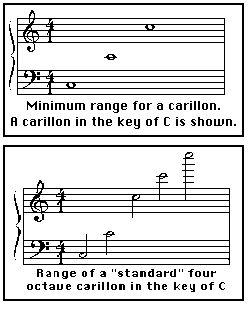 Carillons range in size from two to greater than six octaves, or from a minimum of 23 bells to as many as 77. A range of four to four and one-half octaves (47 to 56 bells) is most desirable, since almost all carillon music can be played on such an instrument. (By comparison, a piano has 88 notes, while an organ keyboard has 61.) Most contemporary carillon music, and much historic music, is written for carillons with a range of four or more octaves. The available repertoire for smaller instruments is more limited.
Carillons range in size from two to greater than six octaves, or from a minimum of 23 bells to as many as 77. A range of four to four and one-half octaves (47 to 56 bells) is most desirable, since almost all carillon music can be played on such an instrument. (By comparison, a piano has 88 notes, while an organ keyboard has 61.) Most contemporary carillon music, and much historic music, is written for carillons with a range of four or more octaves. The available repertoire for smaller instruments is more limited.
The pitch of the bourdon bell of a carillon is often dictated by non-musical considerations, since both pitch and cost are directly related to the size of the bourdon. The largest carillon bell in the world is the bourdon of the Rockefeller carillon in Riverside Church, New York City. It sounds the note C, weighs more than 40,000 pounds (20 tons) and exceeds 10 feet in diameter. A bell sounding its octave (low C in the four-octave range) weighs approximately 5,000 pounds (2.5 tons) with a diameter of about 5 feet. A bell sounding the next octave (middle C) weighs approximately 580 pounds (a quarter-ton) and has a diameter of approximately 30 inches. The size and weight-bearing capacity of the bell chamber also has a direct bearing on the size of a carillon.
Since a carillon is seldom played with another instrument, the bourdon may be any pitch deemed suitable for the installation and funds available. Regardless of the actual pitch of the instrument, it is common for the keyboard to be laid out based on the key of C, to simplify the writing and playing of music for it. Thus many carillons are transposing instruments. This is more likely to be true of small or older instruments; modern instruments are more likely to be in concert pitch.
The carillon evolved as a folk instrument, played automatically as a clock chime, and by a performer for market days and holidays. Surviving music from the first "golden age" is mostly arrangements of folk tunes, dance pieces and popular music of the period, although there are some original compositions for carillon. Like piano music, carillon music is written on two staves: music on the treble or upper staff is played with the hands, while that on the bass or bottom staff is played with the feet.
Early in this century, the ability to arrange music from other sources and to improvise on the carillon was a necessary skill for the carillonneur. The growth of the carillon art in modern times has resulted in a rich repertoire with a wide variety of regional styles.
Care must be taken when composing or transcribing music for the carillon. One feature that sets the carillon off from other instruments is the fact that once a bell is struck, it continues to ring until the vibrations die out naturally. All of the musical expression of which the carillon is capable is controlled by how the performer strikes the bell. There is no way to stop or alter the sound of a struck bell. Dampers are ineffective because they just deaden the sound without stopping it, making it unmusical.
 Another feature of carillon music derives from a prominent minor third in the bell's overtone structure, requiring care in formation of chords. Most musical instruments produce sounds with major thirds in their overtone structure.
Another feature of carillon music derives from a prominent minor third in the bell's overtone structure, requiring care in formation of chords. Most musical instruments produce sounds with major thirds in their overtone structure.
Lastly, the rich tonal structure of a bell means that sounding a large number of bells together is unnecessary. A rich sound can be obtained from just a few bells.
Glossary of Carillon Terms
- action
- The mechanism that transfers the motion of the keys to the clappers of the bells. In a traditional carillon, this includes wires, usually stainless steel, that carry the motion to a bell crank. The crank transfers this vertical motion to a horizontal wire connected to the bell's clapper.
- adjuster
- A turnbuckle device located immediately above each manual key. It allows the performer to compensate for changes in wire length due to temperature changes, so that the clapper is always in the correct position, neither too close to nor too far from the bell.
- baton
- Another name for a manual key in a carillon keyboard.
- bell
- A cup-shaped, cast bronze percussion instrument, sounded by a clapper or hammer.
- bell chamber
- The space containing the carillon and its frame. Also called the "belfry," although that name has to do with the Latin word for a lookout tower, not a location for bells. The bell chamber may be enclosed or completely open, but it must have some openings to allow for the egress of the sound.
- bell frame
- The system of supports, usually either steel or wooden beams, from which the bells of a carillon or chime are hung.
- bourdon
- The largest bell in a carillon, sounding the lowest note. The bourdon is the major factor determining the character of a carillon. The word comes from a term for a musical drone (a continuously sounding low note, as in bagpipes).
- carillon
- A musical instrument composed of at least two chromatic octaves of tuned bells, played from a keyboard that permits expression by variation of touch.
- change ringing
- The traditional way of ringing five to 12 bells in England. The bells in a ring are hung to swing through slightly more than 360 degrees. When ringing, the bells are first swung until the ringers can hold them with the mouth of the bell pointing upward. When it is time for the bell to ring, the ringer pulls the bell rope, overbalancing it, and the bell swings through a full circle, striking once. The ringer stops the bell's swing in such a way that it stops and stays mouth up again. In this manner, swinging bells can be rung in order. The object of the exercise is to change the order in which the bells ring, producing "changes" in the pattern.
- chime
- A musical bell instrument composed of less than two chromatic octaves, but with at least one diatonic octave of bells. That is a range of eight to 22 bells. Chimes are typically American instruments. They are intended mainly to play the melodies of hymns and popular songs, with minimal harmony.
- chromatic
-
A chromatic octave has 13 notes including both the white and black keys of the piano keyboard.

- clapper
- The part of the carillon action that strikes the bell, causing it to sound. Clappers take the form of balls of cast iron or bronze on the end of a rod or shank suspended from a hinge or pivot called the clapper staple. The staple is held by the bell mounting bolts. In a swinging bell, the clapper is free to strike the bell as it swings. In a carillon or chime, the bell is usually fixed to a beam, and the clapper is pulled against the bell by the action. Some carillon bells are hung so that they can swing, as well. In this case, the clapper swings free, and an outside hammer is used to play the bell during performance. A clapper must be a certain portion of a bell's weight; for a heavy bell, some kind of assistance, either a counterweight or counterspring, must be provided for moving the clapper. For light bells, the clapper will be too light to fall back from the bell rapidly enough to allow the bell to ring without being deadened. In this case, a return spring is used.
- clavier
- Another name for the keyboard of a carillon.
- concert pitch
- When applied to a carillon, refers to an instrument that actually sounds the notes implied by the keyboard arrangement, as opposed to a transposing instrument. While carillons may be in any key (see the Carillon Music page), carillon music is commonly written for a carillon in concert pitch.
- console
- Another name for the keyboard of a carillon.
- counterspring
- A spring attached to the action of a heavy bell in such a manner that it balances much of the clapper's weight. It is used to reduce the weight or "touch" of the key.
- counterweight
- A weight attached to the action of a heavy bell in such a manner that it balances much of the clapper's weight. It is used to reduce the weight or "touch" of the key.
- damper
- In string keyboard instruments, a part of the action that stops the string from vibrating when the key is released by the performer. Dampers have been tried on carillons, but the mass and vibration modes of a bell prevent the kind of instantaneous cessation of sound required by music. Bell dampers deaden but don't stop the vibration of a bell.
- diatonic
-
A diatonic octave has eight notes using only the white keys of the piano keyboard.

- dynamics
- Varying degrees of loudness or softness in a musical performance.
- expression
- Qualities the performer brings to a musical performance.
- fifth
- The fourth tone in the series of partial tones produced by a bell. It sounds an interval of a fifth above the prime or a twelfth above the hum tone.
- fundamental
- The lowest tone in the natural harmonic series. Also used to indicate the second tone, or prime, in the series of partials produced by a bell. The octave of the hum tone.
- hammer
- Hammers are similar to clappers, except that they are mounted to the bell frame outside the bell and strike the outside of the bell. Hammers are usually used when a chime or carillon bell is hung for swinging, since the free-swinging clapper can't be connected to the action. Hammers are also used for clock strikes and automated systems.
- harmonic series
- The series of overtones produced by vibrating strings or wind columns. They are caused by the various natural modes of vibration of the sound producer. When the fundamental pitch of the sound producer is changed, as in tuning, all of the overtones change together. This is not true of the partial tones produced by a bell. For a more detailed explanation, see the Wikipedia article on this subject.
- hum tone
- The lowest tone produced by a bell, generated by the vibration of the entire bell. An octave below the prime.
- keyboard
- Also called a clavier or console. The part of a carillon by which the performer plays the instrument. It consists of a frame of wood or metal containing the manual and pedal keys, the pedal action by which pedal keys pull down the manual keys, and the music rack. The keys are arranged so that the black keys are higher than the white keys, as they are in a piano keyboard. The performer sits on a bench in front of the keyboard.
 lathe
lathe- A machine tool used to tune bells. The bell is turned upside down and placed on a rotating base. As it turns, a precisely placed tool cuts metal out of the inside of the bell. (See photo to the right.)
- manual key
- A key, connected directly to its bell, played by the performer's hands. Each key is typically about two feet long and an inch square. It is pivoted at its rear end, with a tapered, conical front end, six inches long, on which the performer plays.
- minor third
- The third in the series of partial tones produced by a normal bell. This tone sounds an interval of a minor third above the prime, or a tenth above the hum tone. It gives the bell its rather plaintive characteristic sound, and is not found in the natural harmonic series. It also requires great care in the formation of chords.
- nominal
- The fifth tone in the series of partial tones produced by a bell; the octave of the prime, and two octaves above the hum tone. Tuning this note tunes the strike note, the note that gives the bell its name. This is usually the highest partial tone tuned by bell founders.
- octave:
- The interval between the first and eighth tones of the diatonic scale. Notes that are an octave apart have the same note name. This is the most consonant harmonic interval.
- overtone
- Usually used to refer to the partials of a musical tone that are harmonically related, i.e, are part of the natural harmonic series.
- partial
- All musical tones, except possibly those produced electronically, are made up of many tones, or partials. These are not necessarily harmonically related. Often used interchangeably with overtone.
- peal
- Usually used to designate three or more bells hung to be swung together. Bells of different weights have different natural swing rates; when three to five harmonically related bells are swung, their changing patterns can produce a glorious sound. Sometimes, several bells in the lower octave of a carillon are arranged to swing as a peal.
- pedal key
- A key connected by a transmission system to its corresponding manual key, which is played by the performer's feet. The key plays the bell by pulling down the manual key. Pedals are typically about 2 feet long, an inch wide and 2 inches high, and are pivoted at the rear end. They have springs that prevent them from hanging on the manual keys and dropping when those are played.
- prime
- The second tone in the series of partials produced by a bell. The octave of the hum tone. The bell is named for this tone. Sounds the same pitch as the strike note.
- profile
- The shape of a bell, the primary determinant of the bell's tone. It is created by the shape of the casting mold and is adjusted in the tuning process.
- return spring
- A spring connected to the clapper of a small bell in such a way that the clapper is pulled off the bell rapidly, so it won't deaden the sound.
- ring
- Five to 12 bells hung for change ringing. The bells are hung to swing through slightly more than 360 degrees.
- strike note
- A rather harsh, short-lived, metallic note sounding the same pitch as the prime. Its pitch is controlled by the nominal. The strike note is the strongest tone when the bell is first struck, but quickly fades, giving prominence to the prime.
- transmission system
- The action of a carillon or chime.
- transposing instrument
- A carillon that, for various reasons, actually sounds a different key than that implied by the keyboard arrangement. See concert pitch.
- tuning
- The process of adjusting the profile of a bell so that the first five partials of the bell bear a harmonic relationship with each other, while at the same time, the bell is tuned to the other bells in the carillon. Tuning is done by cutting metal away from the inside of a bell with a lathe. Once tuned at the foundry, a bell needs no further tuning during its life, unless damaged by corrosion.
Bell Foundries
Active bell foundries that have supplied carillons in North America include:
Based in North America:
- B.A. Sunderlin Bellfoundry, Ruther Glen, VA
- Meeks, Watson & Co., Georgetown, OH
- The Verdin Company, Cincinnati, OH
Based in Europe:
- John Taylor & Co., Loughborough, United Kingdom
- Paccard, Sévrier, France
- Royal Eijsbouts, Asten, The Netherlands
Tower Design and Standards
Keyboard Standards
The GCNA adopted its first keyboard standards in 1970, and the standards were published in the November 1970 Bulletin. The standards were revised in 1981, although the revised standards were not formally published until 2006. The standards are now included as Appendix D in the GCNA Carillon Tower Design and Construction resource booklet.
View Keyboard Standards.
Tower Design
A booklet titled Carillon Tower Design and Construction was written in 2005 by Patrick Macoska as a resource for architects, engineers, contractors and others contemplating the planning, design, construction or renovation of a carillon tower. Mr. Macoska revised and published the booklet in 2006, and it now includes the GCNA Keyboard Standards as Appendix D. Mr. Macoska is a registered architect in the state of Michigan and is chairman of the GCNA's Tower Construction and Renovation Committee.
View entire Carillon Tower Design and Construction booklet.
If you have questions about the booklet or if you have a question that the booklet does not answer, contact Patrick Macoska.
Contact us | Privacy Policy
Copyright © . All rights reserved.


